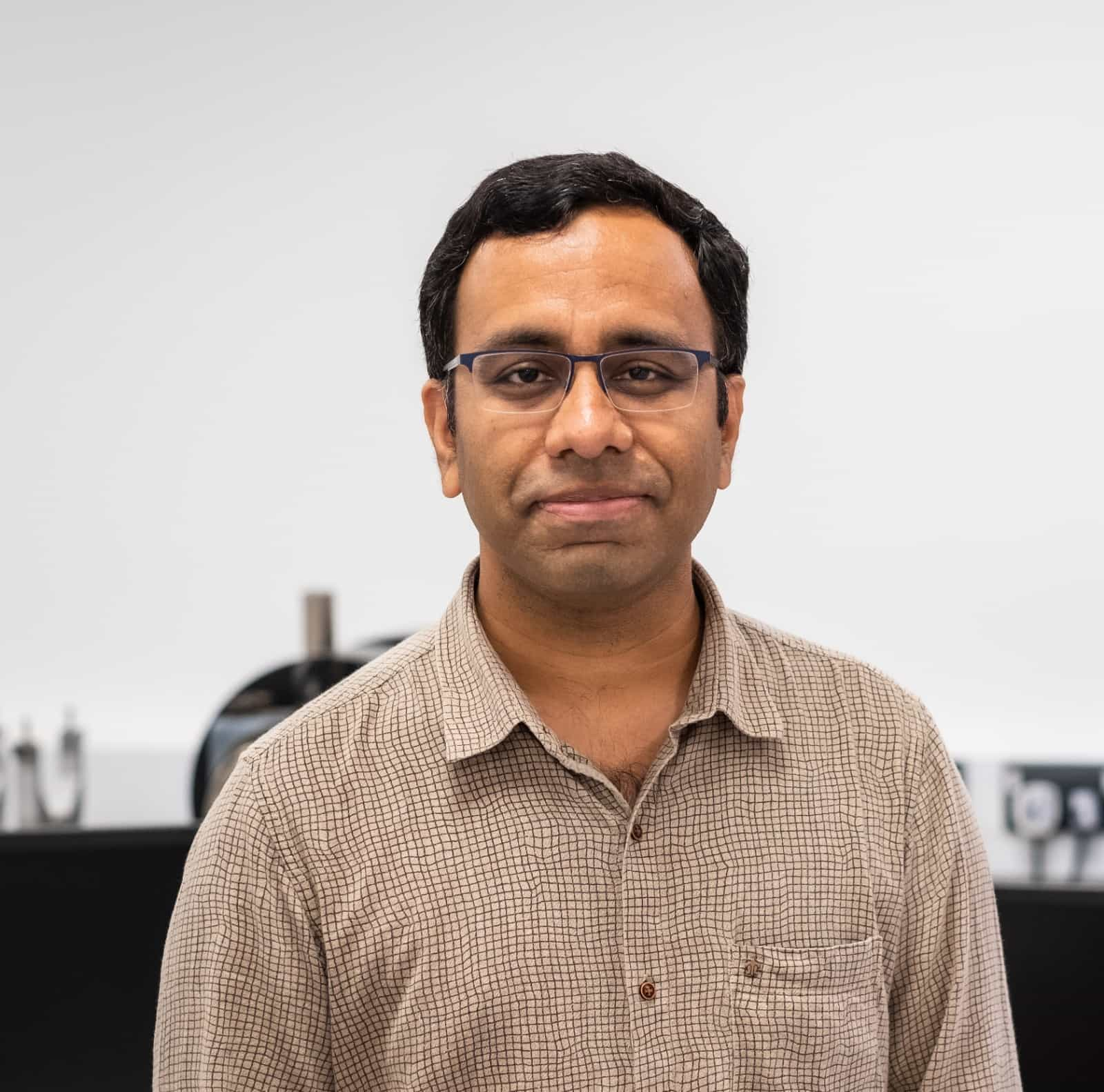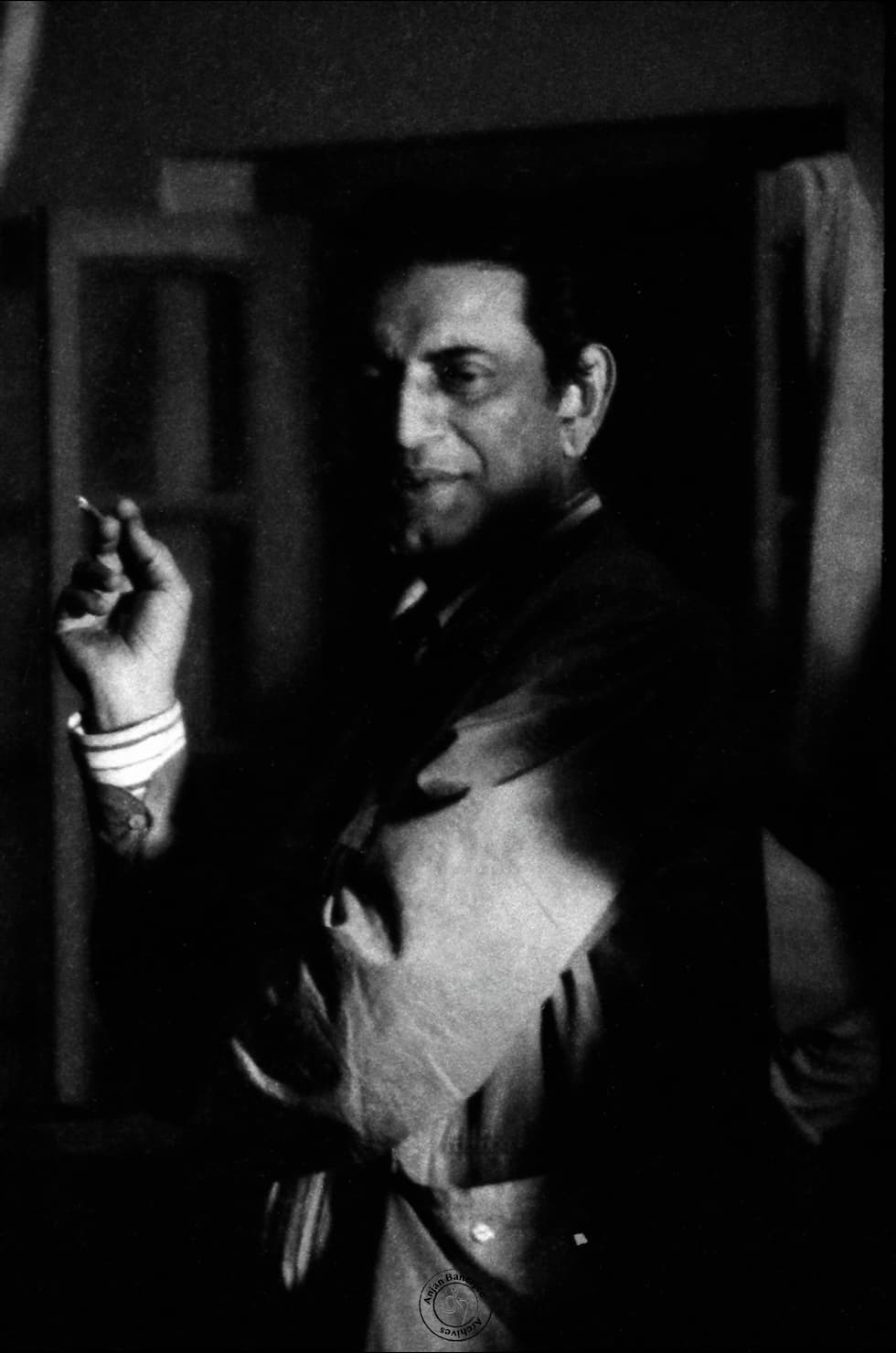
A diary, a trunk-full of prints and a gnawing void were all that 11-year-old NILADRI BANERJEE was left behind when he lost his father in 1995. In between, he did his PhD and postdoctoral research at Cambridge, taught at Loughborough University before joining London’s Imperial College. Here is the exclusive story of photographer Anjan Banerjee from the sets of Seemabaddha, Jana Aranya, Ashani Sanket, Sonar Kella and Hirak Rajar Deshe. Here is the story of how a Ray of light filtered into the dark room of a bereaved son trying to discover his father from behind the lens
Why BFA commissioned this piece:
There are stories that need to be told. There are stories that need to be shared. There are stories that need to be archived. We were intrigued when we first heard about physicist Niladri Banerjee’s personal journey. He was then shifting between his jobs at Loughborough University and Imperial College. In between his farewell parties and welcome addresses, he took time out to give us a sneak peek into his treasure trove.
Those carefully restored prints made us nostalgic. Niladri’s reflections also made us privy to another experience. It was about how cinema helps to transcend loss, strengthen old ties and create new ones. Niladri accepted our offer to share this experience with the rest of the world and graciously agreed to shoot a long-distance promo for BFA with director Amitabha Chaterji
I lost my father when I was all of 11 years. Like any other child of that age, the loss was painful. I barely got enough time to bond with him, leave alone get to know about his works. All I knew was that Baba was an amateur photographer who, despite not being part of Satyajit Ray’s unit, had the unique privilege of being on the sets of at least five of his films — Seemabaddha, Jana Aranya, Ashani Sanket, Sonar Kella, and Hirak Rajar Deshe.
My father, Anjan Banerjee, was the sales manager of a pharmaceutical major. Way before beginning his professional life, my grandfather made Baba-Kaka members of Sandesh around 1962-1963. That was where he got introduced to Ray. I still have a letter from Ray’s aunt, Nalini Das, to my grandmother asking her to do her bit to give a push to the subscriber base of Sandesh. During this period, Baba slowly developed an interest in photography. It was sometime around 1965-66, as a 13-14-year-old boy, he started pursing photography.

Ray had already directed Pather Panchali (1955), Aparajito (1956), Parash Pathar (1958), Jalsaghar (1958), Apur Sansar (1959), Devi (1960), Teen Kanya (1961), Kanchenjunga (1962), Abhijaan (1962), Mahanagar (1963) and Charulata (1964). Baba started frequenting the Ray household sometime in the 1970s. Sandesh was the common link. By that time, he had already started engaging himself in serious study of cinema. He had done a course at the American Centre and even written two scripts for a short documentary and a cartoon film. Most likely, those were written during the time when he was doing this course at the American Centre. Unfortunately, these never got made into films. I don’t know if Ray had seen those scripts. But the timeline suggests that it was written around the time he interacted with Ray.
Today when I sit back and reflect, I feel such proximity with Ray could have resulted in countless evenings of story-telling at our Ballygunje residence. I can almost picturize myself as a little boy sitting next to my father while he introduced me to the legend... But, destiny had other plans for me. I was around nine when he was taken ill following which the discussions were mostly about his treatments. I have clear memories of him showing me some interesting experiments. That triggered my interest in science which later became a passion and eventually a profession.
The other memories are mostly about him teaching me the art of photography. Before his demise from cancer in 1995, Baba had shown me a few photographs he had clicked of Ray. Unfortunately, he could leave behind little verbal account of his experiences. But what he left behind was no less precious. It was a veritable treasure of some 200-220 photographs, quietly tucked away in a trunk and a diary where he painstakingly scribbled his on-the-sets notes.
In spite of a heavily-demanding professional life, the memories of the Ray photographs never left me. All these years, I had all the photos of Ray in my possession but did not want to risk giving them to anyone for the fear of the prints getting stolen. We have had the misfortune of some of those prints getting copied
I knew that those photographs were safely kept in a trunk atop an almirah at my grandparents’ place in Ballygunje. It was not until 1999 that I could finally go through that trunk. Since I had grown up in a culture where Baba’s treasure trove was extremely well-protected, I never had the courage to rummage through them. I had seen how carefully he handled the negatives and the photographs. No one was even allowed to enter his room when he was developing the negatives. Everything was supposed to be handled with kid gloves. So, I practically did not have the confidence to touch the trunk till I knew I was mature enough to protect its content.
As I said, Baba himself used to develop most of those photographs. That’s why the trunk had a collection of developed positive prints as well as the original negatives. Some 10 of them were also autographed by Ray. The jewel in the crown found a pride of place on one wall of the living room of our Ballygunje residence. The opposite wall had another jewel — a portrait of Abanindranath Tagore by my grandmother’s uncle Mukul Dey. He was Abinindranath Tagore’s student, and a pioneer of drypoint-etching in India.
More than a decade later following my father’s demise, academic career became my primary focus. I shifted out of Kolkata and started my academic career in the University of Cambridge. England became my second home while I embarked on a career of a physicist. I got busy with my research in experimental condensed matter physics to understand the behaviour of electrons in materials thinned down to less than five thousand times the width of a human hair and cooled to -270°C.
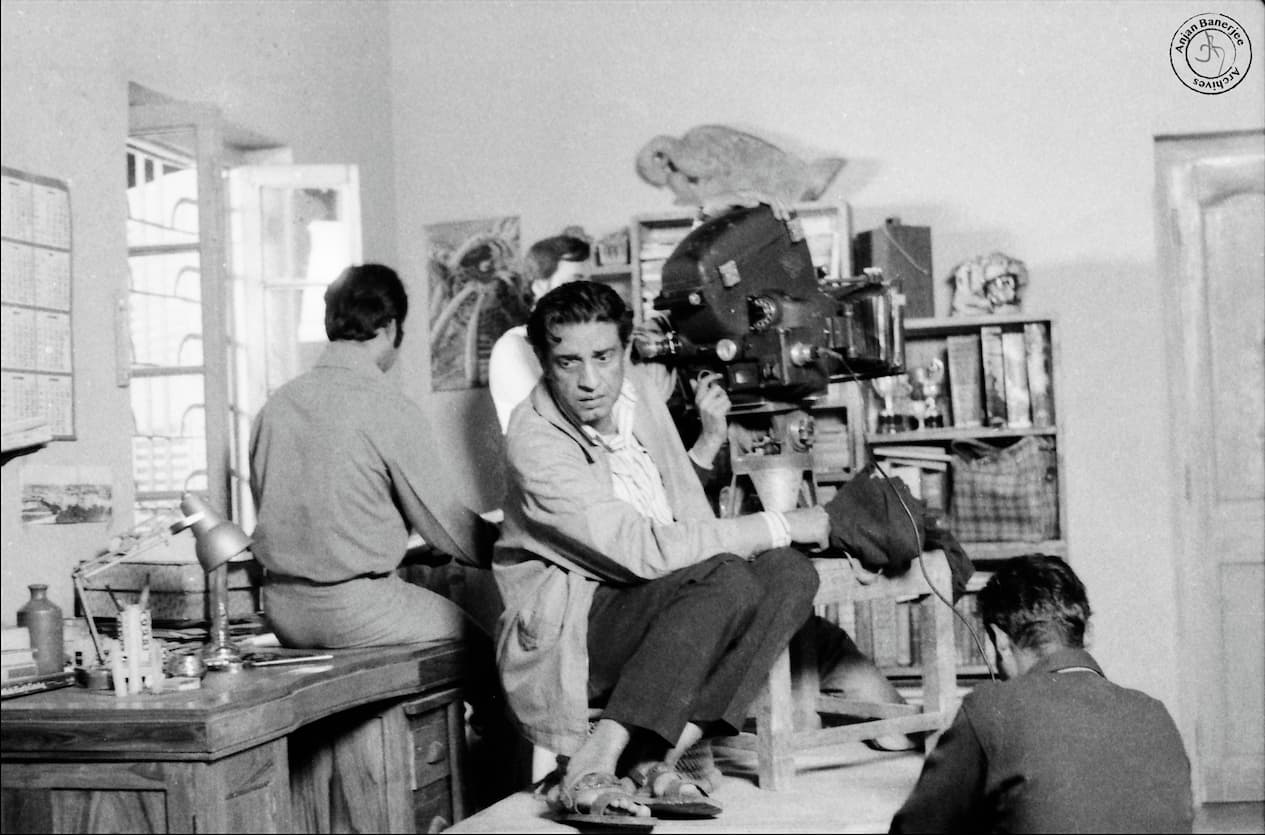
In spite of a heavily-demanding professional life, the memories of the Ray photographs never left me. All these years, I had all the photos of Ray in my possession but did not want to risk giving them to anyone for the fear of the prints getting stolen. We have had the misfortune of some of those prints getting copied. That perhaps explains how few of Ray’s photos clicked by Baba are in the public domain without due credit.
Those who are religious say there is a time for everything and a season for every activity under the heavens: a time to be born and a time to die, a time to plant and a time to uproot. Perhaps that is somewhat true in my case. A pandemic, some reminders and unexpected coincidences have finally made me open my stockpile. Just before the pandemic broke out, I decided to buy a Canon scanner and start work on scanning those sepia-toned photos. The scanning now over, my main focus is to restore the photographs.
Apart from Ray’s photos, Baba also left behind a collection of some 1000-odd photographs, old magazines and a rare collection of art books my uncle purchased in England in the 1950s. I have managed to partially scan the magazines and am currently restoring a few.
Scanning the photos always ends up jogging my memories. I sometimes go back in time to the days when Baba would narrate his experiences to all of us. Our childhood memories are akin to a child playing on a beach. One never knows which small pebble the child will pick up from the beach and store in the treasure bag. This has striking similarities with my recollections. Some stories I remember distinctly while others I couldn’t retain. Not because I didn’t want to but simply because I couldn’t.
Another big possession in the trunk was a dog-eared diary where Baba wrote some shooting details. That’s where he mentioned that it was in the August of 1972 that Ray began the outdoor shooting of Ashani Sanket in Bolpur. Shooting for the film, which went on to win the Golden Bear at the Berlin Film Festival, began on the peak of monsoons. Ray had used the Kodak Eastman Colour films for shooting this feature film. Baba had a Canon camera and ORWO NP 55 film. Those who still work with films will remember that the ORiginal WOlfen was an East German company that was renowned for being one of the best producers of film. This cine film is reasonably priced and had exceptional resolution. I gather from my uncle that Ray had proposed to indophile David McCutchion about using ORWO films during his important research on terracotta temples.
Till the time the actor got this right, Ray apparently continued to make her rehearse. Not once did he say that she was short of his expectations. Rather, he encouraged her saying every rehearsal was “better” than the one before. To respect the sentiments of a newcomer on the sets, extract the desired performance while giving her due respect of an artist is also an art by itself
It had rained heavily on the first day of the shooting of Ashani Sanket. The sky was overcast. Some were apprehensive that the weather would play spoilsport and stall the shoot. But Baba was optimistic. He insisted that Ray’s script had demanded that kind of weather. Once Baba reached close to the shooting location, he could spot many curious onlookers. Cops intervened soon after and dispersed the crowd. “Satyajit-babu was discussing the shot with Subrata-da (Subrata Lahiri). Filming began soon after,” Baba wrote in his diary.
The first scene to be shot was of Dinabandhu Bhattacharya (played by Gobinda Chakraborty) walking past a bamboo bridge and entering Gangacharan’s (played by Soumitra Chattopadhyay) house. Ray got busy explaining the next shot to Babita once this take was done. He explained the camera position to the assistant cameraman. “Satyajit-babu also explained the dialogue delivery pattern to both Soumitra-da and Babita,” Baba wrote. The next scene had a disgusted Gangacharan not taking kindly to Dinabandhu’s presence and telling wife Angana (played by Babita): ‘Ore ami chinine? Moha dhoribaaj lok (Don’t I know him? He is a very shrewd man)’.
I could almost visualize the scenes when I leafed through the pages. Problems cropped up on the second day with the bright sun rising on the horizon. The shooting location was changed to avoid the sun. Ray first took a ride to the Goalpara house and announced that the morning shots would be canned there. Soumitrada was asked not to shave, Baba wrote.
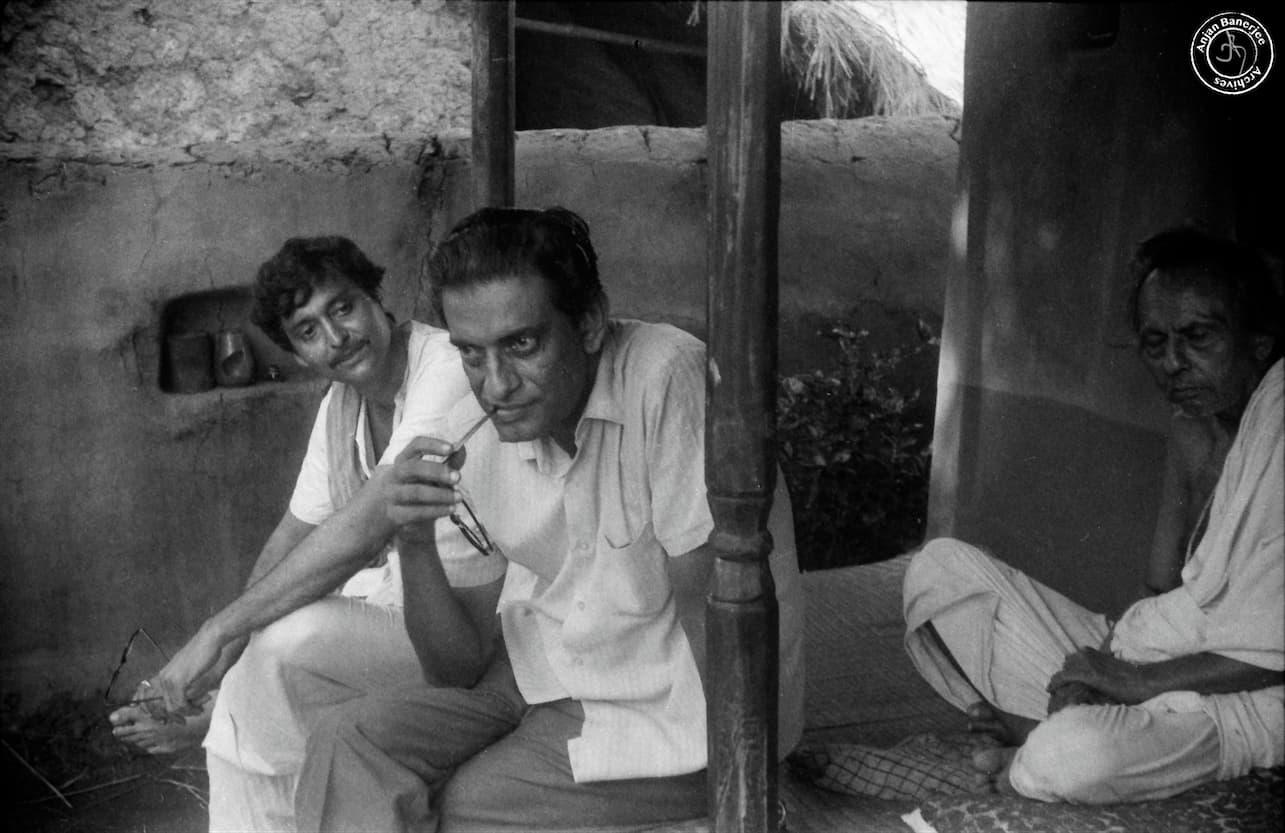
A candid moment of Satyajit Ray, along with Soumitra Chatterjee and Gobinda Chakraborty, during the shooting of Ashani Sanket
Once at the spot, arrangements were quickly made for shooting. A cot was placed on the verandah. Someone, who had suffered a head injury on the hands of the villager, was asked to lie down there. A bandage was about to be wrapped around his forehead when Ray engaged in a conversation with an elderly villager. Before he could give some suggestions, Ray said: “Isn’t there a practice of applying some grinded and pasted blades of grass on the injury spot to stop bleeding?” The elderly villager immediately responded saying: “Yes, that’s the practice. It had completely slipped my mind”.
As I leafed through the diary, I couldn’t help appreciating the great eye for detail Ray had. Another interesting detail was the way Ray handled new actors on the sets. Baba narrated an incident involving a fresher named Shubhra Nath who was an aspirant of the Film and Television Institute of India. She was cast in the role of the daughter of this injured man and was supposed to sit on the floor, anxiously waiting for her father to respond. It was her first day and she took some time to get into the character. In great details, Baba mentioned how Ray encouraged her to get the dialogue delivery right. He explained that it was only natural for the character to be tense since she was unaware of whether her father was alive or not. Her tension would dissipate only after her father responded. The character’s dialogue delivery was supposed to be in sync with this emotional graph. Till the time the actor got this right, Ray apparently continued to make her rehearse. Not once did he say that she was short of his expectations. Rather, he encouraged her saying every rehearsal was “better” than the one before. To respect the sentiments of a newcomer on the sets, extract the desired performance while giving her due respect of an artist is also an art by itself.
On another occasion, he was filming in the courtyard. The camera stopped functioning out of nowhere. An assistant cameraman said that the machine had got jammed. Punning on the word ‘jam’, Ray said: “Now, let’s see how much of jelly and marmalade you make out of this!”
Once the take was over, the unit got busy setting up a trolley shot. So many images from the film flashed on my mind while reading through this account. The first was the symbolic opening scene of the impending epidemic. Gangacharan was returning home in a bullock cart after finishing the Olaichandi Puja when Dinabandu returned to say that he was going to bed hungry because there was not a morsel of food available for him at home. At the end of the dialogue, Dinabandhu’s voice got drowned by the shrill cry of a bird.
This entire scene was canned at Ballavpur. Baba had beautifully penned the behind-the-scenes account. “The sky had taken on a brilliant hue. Satyajit-babu had come and checked the skyscape. Before canning the shot of Dinabandhu-babu asking for alms, Satyajit-babu acted out the scene with great finesse. Immediately after shooting, he walked all the way to the farm in front and then navigated through the mud to reach right in the centre from where he could take an extreme long shot. He had somewhat squatted on the road while canning the bullock cart scene. Unfortunately, the film had run out right in the middle of the shot. Slightly irritated, he had punned on the word ‘poth’ and said: ‘Tomra ei bhabe amar chhobitake maar khawabe aar amake pothe boshabe?’ Tokhon uni pothei boshe (‘Is this the way you will sabotage my film so that I am left on the streets?’ He was seated right on the road then).
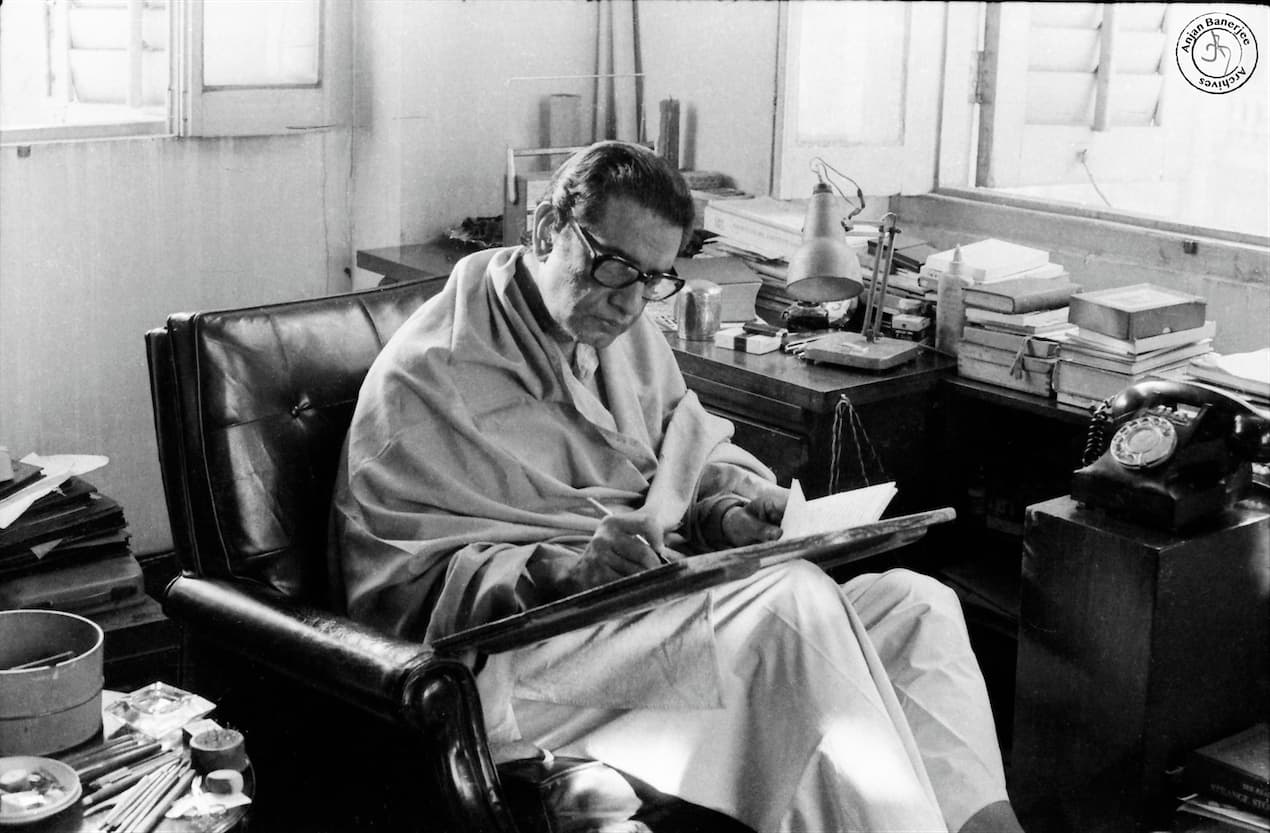
Satyajit Ray at his Bishop Lefroy Road residence
On another occasion, he was filming in the courtyard. The camera stopped functioning out of nowhere. An assistant cameraman said that the machine had got jammed. Punning on the word ‘jam’, Ray said: “Now, let’s see how much of jelly and marmalade you make out of this!”
Baba’s diary has some accounts of funny incidents about Gobinda Chakraborty. The actor was hard of hearing. There was one morning scene where he was supposed to be lying down when Soumitra-babu was supposed to come and speak to Babita. Hearing Soumitra-babu speak, he was supposed to wake up and then say, “Pennam panditmoshai.” Ray had apprehended that Soumitra-babu’s dialogue might not be audible for Gobinda-babu. So, he offered to call him up to give him a cue. This process worked fine during rehearsals. Soon after the sky cleared up, resulting in a delay in filming. During the final take, Ray gave the cue. But instead of mouthing his dialogue, Gobinda-babu turned around and said, “Bolun! (yes, tell me)”. Ray immediately said ‘cut’ and reminded Gobinda-babu that he was actually supposed to get up on hearing the cue. Ray had enjoyed that moment and Baba remembered him taking the entire episode in good humour.
Between September 18 and 25, Baba had returned to the village for filming the second time around. The unit was there from September 9 onwards. Shooting had begun on the 10th. “This time around, there were additional locations like Taltore and Saddiqpur. Ananta-da (makeup artist Ananta Das) had recorded every verbal instruction of Satyajit-babu to his artists. The recordings were often replayed on the sets. One such recording was with Gobinda-babu for the scene where he didn’t remember the dialogue cue. Soumitrada, Satyajit-babu, Ananta-da and I had replayed the scene on the tape recorder and shared a good laugh over it,” Baba wrote.
These writings and photos were all good but something was missing. It was the desire to get closer to what my father had experienced. Perhaps to speak to someone directly from Ray's unit. It was a stroke of luck that I happened to get in touch with Anil Ghosh who was the focus-puller in the same unit. I could immediately feel the warmth in the octogenarian technician’s voice when he said, ‘Tumi Nil, ami Anil’ (You are Nil, I am Anil – punning on the word Nil). He had never met me personally... Yet, there was a sense of earnestness in him to help me with some recollections that would strengthen my paternal bonding
The indoor shooting began on November 1 at Indrapuri studio. Baba wrote in his diary: “I saw that the two houses of Ballavpur had been recreated on the sets. Lights were adjusted from the morning. Gobinda-babu had quite a few scenes with Soumitra-da. Scenes with Babita and Sandhya Roy were shot later on. Shooting took place at the studio between November 1 and 3”.
What makes reading these accounts a fascinating experience is Baba’s reportage style. He had an eye for narrating all the funny incidents that happened on the sets, sometimes adding his own commentary in just a line. “There was a scene where Gobinda-babu was having puffed rice with milk. Soumitrada was seated in front. After three sips of milk, Gobinda-babu was supposed to lift his head. Rehearsal was done once. Before the final take, he looked at the sound recordist and said: ‘I will not do any more rehearsals. Otherwise, Gobinda-babu will finish off the milk and puffed rice served to him,” Baba wrote.
Another detail I remember was about Baba sharing with me the spirit of Ray’s team and how they all made Baba feel at home, despite him not being in the unit. Among them were cameraman Roy-da (Soumendu Roy), makeup artist Ananta-da (Ananta Das), assistant Punu-da (Ramesh Sen) and assistant director Subrata-da (Subrata Lahiri). Though Baba was not directly associated with the unit, they showered their unconditional love on him and even taught him the art of photography. The diary jottings of the second day of shooting clearly reveal that. “…I reached at 6 am. Everyone was ready. Breakfast was being served. I was not part of the unit and hence, moved away and sat on a jeep parked close by. Ananta-da would have none of that. He pulled me by my hand and dragged me to the breakfast table. Subrata-da was equally persuasive and both of them ensured that I joined them for breakfast”.
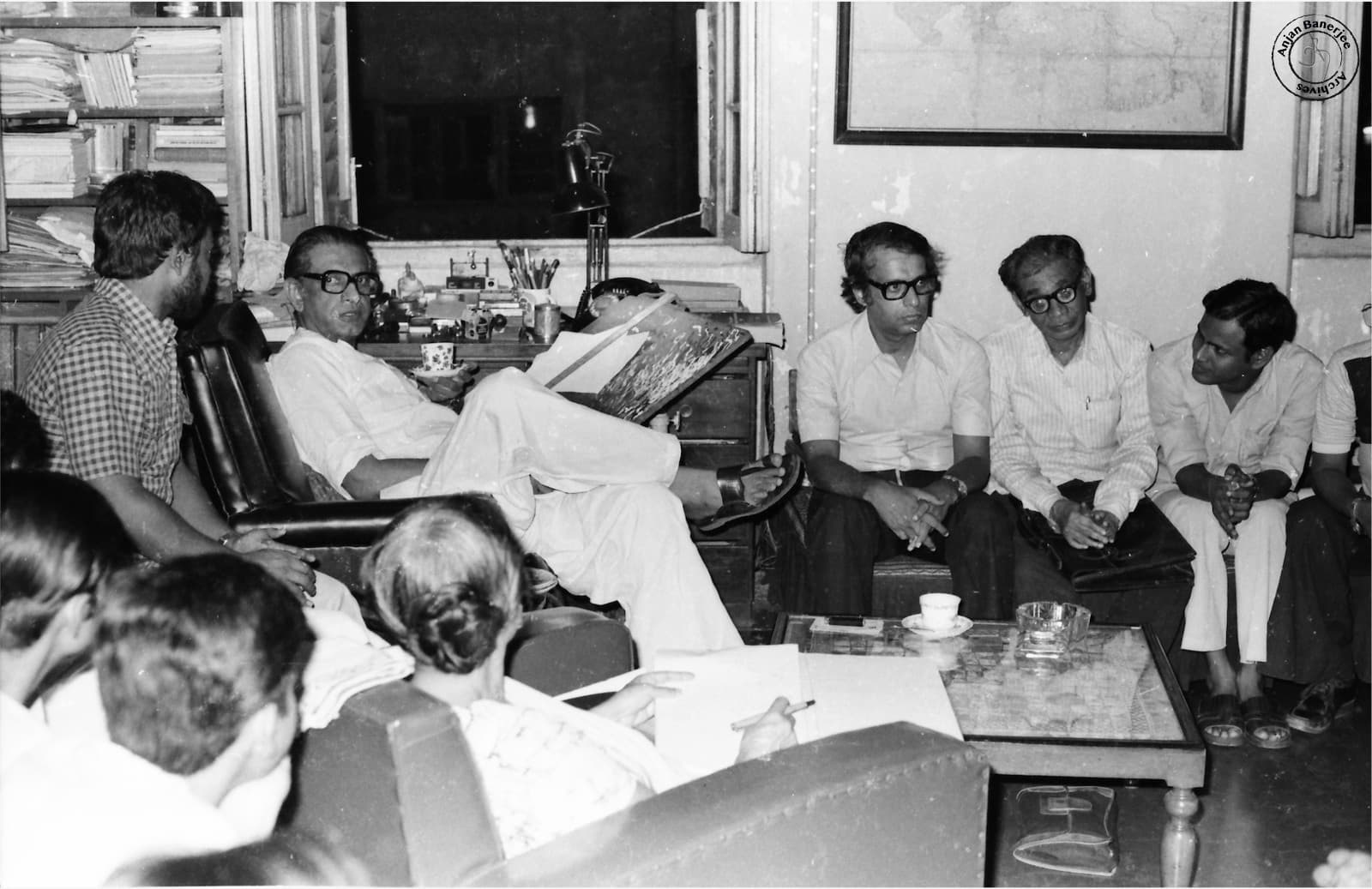
It was a stroke of luck that I happened to get in touch with Anil Ghosh who was the focus-puller in the same unit. I could immediately feel the warmth in the octogenarian technician’s voice when he said, ‘Tumi Nil, ami Anil’ (You are Nil, I am Anil — punning on the word Nil). He had never met me personally. His failing memory could only place my father’s name. But it was difficult for him to share Baba’s stories. Yet, there was a sense of earnestness in him to help me with some recollections that would strengthen my paternal bonding. He narrated to me stories about the unit staying at the Bolpur lodge and how cops had offered to give them protection since the shooting happened during the Naxal movement. He told me how Ray had politely turned down the request because shooting under cop protection would not yield the desired results. He also shared with me stories about Babita and how she would even cook for the unit while the shooting was in progress. As I heard the stories, I was tempted to ask if Baba too was there with the unit members when all this was happening. Baba’s diaries have no such mention. I did and he made futile attempts to jog his memories. I didn’t get the stories but what I got from him was a vibe and a reassurance of not being an outsider. “Nil, your father isn’t around. But I am there…” he told me.
At this age, living far away from home in England, busy with my professional life, I hardly ever get to hear such lines. Nobody here feels this way. Nobody here says such lines. Nobody here fathoms what goes on in the mind of a son searching for clues to help him know his father better.
But he did and by doing so, he made me feel so inclusive. Perhaps, in the same way that Ray’s unit had once made Baba feel when they had dragged him to the breakfast table so that he didn’t feel left out.
When such thoughts race in my mind, I wonder if photographs should only be celebrated as frozen moments in time. Or do they tell something more? While these photographs might have their own historical importance, for me they represent a more personal journey. It is a journey of discovering a side of my father which I never got to know when he was alive. Although these photographs only tell a partial story and the gaps are too large to ever be satisfactorily filled up, for me it is an ongoing journey of discovering him. As a physicist, this journey is no less exciting than unraveling a puzzle of nature. Bits and pieces of the story are hard to come by, but then some parts suddenly fall in place illuminating a part of him and his adventures — a feeling which is exceptionally rewarding.
For more photos, turn to Rare Gems

